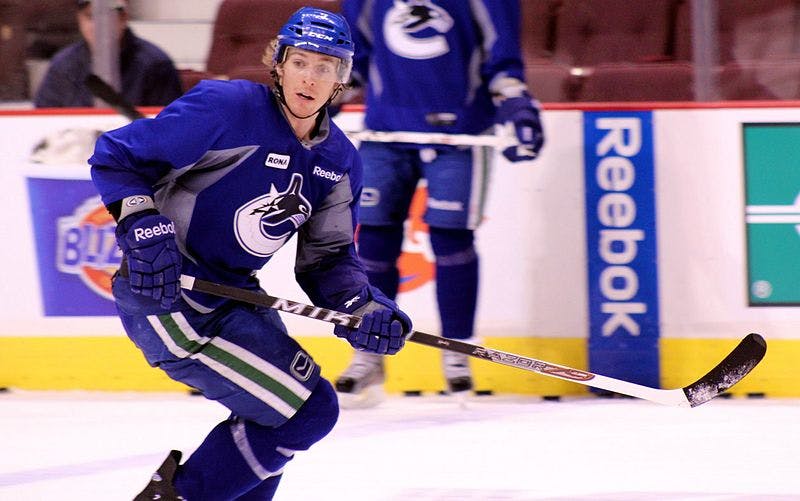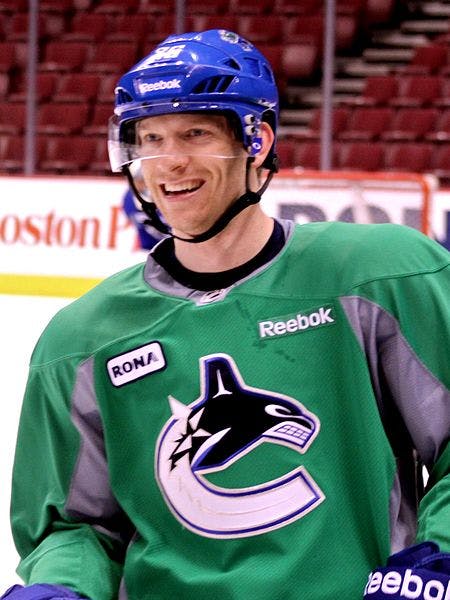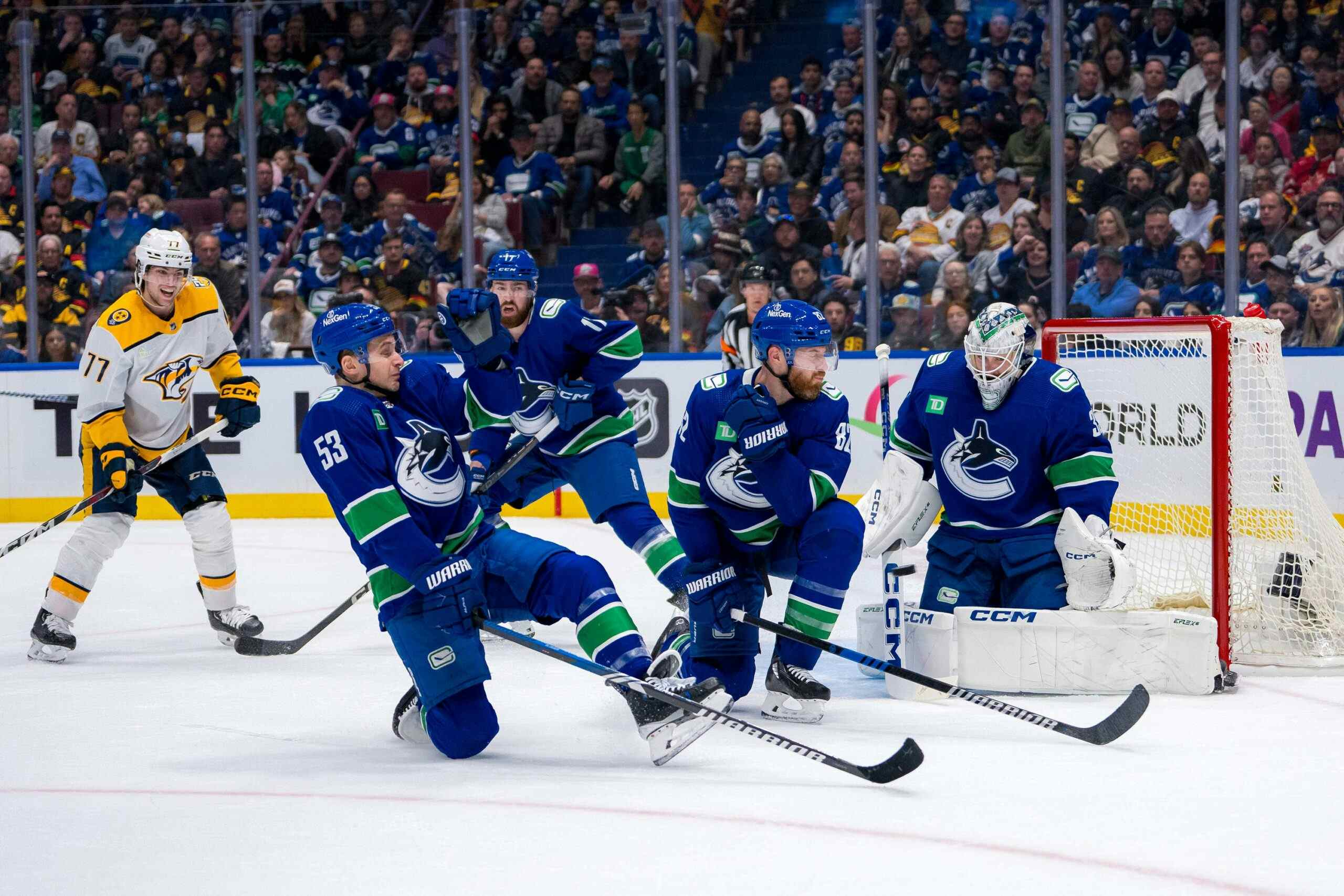Canucks Team Needs: Secondary Scoring
By Jeff Angus
10 years ago
We kicked off "Team Needs" week at Canucks Army on Monday with a look at third-line centre options this offseason. That series continues today with a look at top-six forward options.
I looked at some second line options last week (including David Clarkson and Valtteri Filppula), and that analysis will be expanded upon a bit in today’s post. Let’s assume that Ryan Kesler remains at center and the Canucks find themselves in the market for a top six right winger at a bargain basement price (a very realistic scenario). Who is available in-house? How about on the trade market?
The Diagnosis
Secondary scoring has been a problem with the Canucks over the past two seasons, especially in the playoffs. David Booth was brought in to help in that department but outside of a solid stretch of play in 2011-12, he has failed to deliver in the way of tangible production. Basically David Booth drives play when he’s healthy, but he doesn’t drive offense.
Assuming that David Booth and Ryan Kesler are put together on the second line, and that in an ideal world Jannik Hansen and Chris Higgins hold down third line roles, what type of player do the Canucks need to best compliment them? The answer is an easy one – a playmaker. That doesn’t mean that the third player on that line has to be Henrik Sedin 2.0, though, which is good since that player doesn’t really exist. Booth and Kesler are both shoot-first players, and finding a winger who sees the ice and can get both of them the puck in prime scoring areas would be the best course of action for Mike Gillis to take.
Playmakers typically play center, as the position allows them to spend more time with the puck on their stick (which is why many believe that Kesler may be best suited for the right wing with a more "typical" center). However, there are a number of elite (or very good) playmakers on the wing, including Martin St. Louis, PA Parenteau, Daniel Sedin, and Patrick Kane.
For all of his faults, Booth is still relatively young, he has a proven track record of production, and his underlying numbers have always been good. I think the eye test is just as important in Booth’s case (bad luck has been a factor, sure), and he hasn’t really looked comfortable in a Vancouver sweater. He zigs when his linemates zag. He shoots when he shouldn’t, and seems to have trouble at times with even the most basic stickhandling maneuvers. He was particularly out of sorts during Vancouver’s first round defeat against Los Angeles in 2013.
We all know what to expect from a healthy Kesler. He’s one of the best two-way forwards in hockey. He’s a power play dynamo. He wins faceoffs and plays a lot. But can he maintain his aggressive style of play and avoid injury? Kesler hasn’t just had a few bumps and bruises over the past two years – torn labrums in both his hip and shoulder. Each of those is a very serious injury, procedure, and extensive recovery.
Possible In-House Solutions
Zack Kassian
In a perfect world, the Canucks use whatever limited cap space they have this summer (currently none) to find a third line center and another defenseman, and Kassian reports to camp ready to play top six minutes. Kassian is exactly what the second line of Booth and Kesler would need in a linemate – he’s not fast, but he can keep up with them in terms of skating. Kassian’s best attribute is his vision and creativity. We have seen flashes of it over the past few years, but he is still lacking in the consistency department.
An example of said vision:
The Canucks won’t be expecting Kassian to play top six minutes next season (at least they shouldn’t). However, it would be a major boon to the team if he came to camp and earned that second line spot. He has top six abilities, but they don’t show through consistently. Basically he has yet to take the next step with his development. Kassian ultimately is too skilled to be just a physical third or fourth line presence, and his solid first round against the Sharks (one of only two or three Canucks who can say that) was an encouraging sign heading into the summer.
Nicklas Jensen
On paper, at least, Vancouver’s 2011 1st round pick is also a great fit for a potential Booth-Kesler line. Jensen is a big body who sees the ice very well. Like Kassian, he isn’t a speedster, but he can move around the ice just fine. Jensen has more offensive upside than Kassian, but he also has more limited NHL experience. The Canucks definitely won’t enter the offseason assuming that he is ready for top six minutes (heck, even penciling him into the lineup is a stretch), but that doesn’t mean that they can’t hope for it.
The team wants to get bigger, younger, and stronger? Jensen hits all three of those.
Jannik Hansen/Chris Higgins 
Hansen and Higgins are both “tweeners” – players who are capable of playing on a scoring line in a pinch, but much better suited for third line responsibilities on a contending team. And if you promote one of them to the second line, you create another hole on line three.
The Open Market
I highlighted several UFA options last week. Among the players profiled – David Clarkson, Nathan Horton, and Jarome Iginla. Clarkson isn’t a playmaker in the slightest, but he is a possession monster who plays with an edge and makes his living in and around the opposition’s crease. He’d be the ideal signing for many teams this summer, Vancouver included. However, because of his unique attributes, he is very likely to command upwards of $5 million per season.
Here are a few other UFA options to fill the right wing position on line two:
Michael Ryder
Ryder has defied the typical production path of most offensive players, hitting career numbers in his early 30’s. He’s more scorer than playmaker, and he doesn’t bring a lot else to the table other than that beauty wrister. But offense is exactly what has let the Canucks down in recent years. Ryder had 21 points in 27 games with Montreal after coming over from Dallas last season, and he scored 35 goals with the Stars in 2011-12.
Montreal won’t be bringing him back, and the Canucks previously took a look at Ryder during Gillis’ first summer on the job in 2008 (Ryder turned down Vancouver’s three-year $12 million offer to sign an identical one with the Boston Bruins).
At the end of the day, Ryder has five 25+ goal seasons in the NHL. He can put the puck in the net. He turned 33 this summer, and something in the two-year range would be an ideal fit for Vancouver.
Damien Brunner
Brunner had a very solid North American debut with the Wings in 2012-13 – 26 points in 44 games, and five goals and nine points in 14 postseason contests. Although he isn’t big or particularly fleet of foot, he’s a skilled offensive player and is only 27 years old.
The Canucks got a sampling of what he can do back in late February:
Brunner only scored two goals in his final 25 regular season games, though. Was it other teams figuring him out, or did he hit a bit of a wall after scoring 10 in his first 19? Brunner played 91 games this season, combining his time in Switzerland during the lockout with his NHL rookie campaign. That is a lot of hockey for someone used to 40 or 50 games a season.
Brad Boyes
Boyes went to the Islanders on a cheap one-year deal and rebuilt his offensive game (and subsequently his value as a free agent). It was a calculated risk, and one that will likely pay off for him come July 5th. Playing with John Tavares and Matt Moulson will be his meal ticket to a big contract. He’s a solid player, and he has scored 40 goals before (although that was a while ago). Is he the right fit for the second line? Probably not, but he won’t cost as much as Clarkson or Horton.
Clarke MacArthur
Clarke MacArthur has failed to "eye test" for many Leafs fans, and also for headcoach Randy Carlyle. But he’s been immensely productive in the recent past, is an under-rated playmaker, and drives play. Moreover, because he struggled last season in a severely limited role, he’ll come an awful lot cheaper than the likes of Horton and Clarkson – players he’s ultimately very comparable too. MacArthur might be one of the best potential value players on the market this summer.
Danny Briere
With the addition of Mark Streit, the writing is on the wall of Danny Briere in Philadelphia. Forty-eight hours after the conclusion of the Stanley Cup Final, Briere will be bought out and free to sign a standard player contract with the other 29 teams in the league. Briere’s value has likely atrophied as a result of his diminished production the past couple of seasons, though as Cam Charron pointed out over at TheLeafsNation at least some of that is percentage and luck based. Briere has spent time playing the wing during his career, and certainly qualifies as a "playmaker" of the sort that we’re talking about.
It is tough to speculate who the Canucks could pursue this summer, as they have zero cap space right now. There will be a lot of moving parts leading up to July 5th, though.
The Trade Market
For speculation’s sake, we looked at who the Canucks could target if they were to trade Alex Edler this summer (including Loui Eriksson, TJ Oshie, and Sean “every team wants to trade for me” Couturier. After seeing some of the contracts paid out to defensemen over the past week or so (Sergei Gonchar, Mark Streit, and Roman Josi), I think we can safely say that trading Edler (short of a monumental return) would be a significant mistake, even for a team relatively rich in defensemen.
If Edler is off the table, there really isn’t much in the Canucks organization that could be dangled to land a second line forward. The team won’t move Jensen, Kassian, or Brendan Gaunce. Maybe Chris Tanev if the team and him can’t come to terms?
Conclusion
Assuming that Ryan Kesler and David Booth can remain healthy next season, a huge if, there are a few unproven options within the organization who might fill out the second line. Options outside of the organization, meanwhile, are more proven but likely too expensive.
Finding the right fit for the second line depends on that lines actual makeup (I could see Booth playing a third-line role next year, for example) and how that line will be utilized. What’s clear is that, cap-crunch aside, the Canucks need additional secondary scoring depth. How much cap space the Canucks can create between the end of the finals and July 5th, however, will ultimately determine what sorts of players the Canucks can target.
2013 Team Needs:
Recent articles from Jeff Angus





